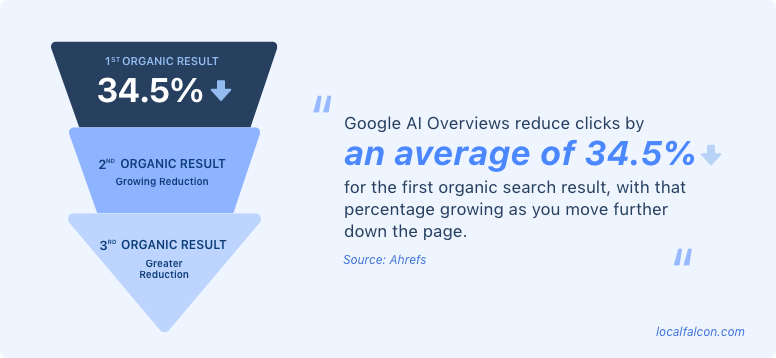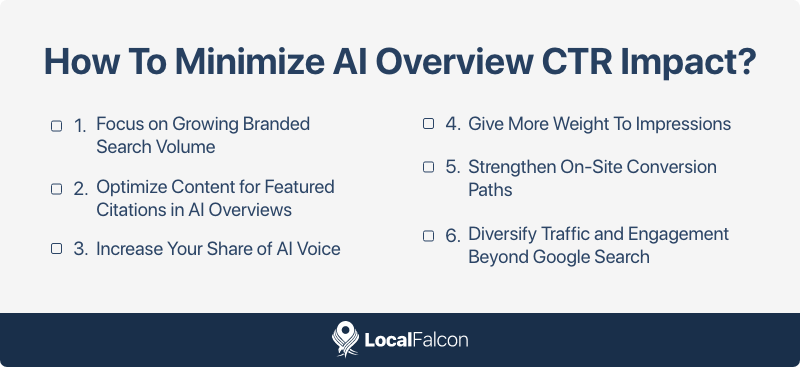AI search has certainly been in the spotlight in 2025, with businesses and marketers scrambling to keep up with trends and ensure continued visibility and engagement in the AI era.
One such trend is a noticeable decline in one of the most important traditional SEO metrics: click-through rate (CTR).
With AI search on the rise, the correlation between AI-generated search results and declining CTRs is clear, with Google's own AI Overviews being one of the major culprits behind the trend. But how exactly do AI Overviews impact Google CTR? Let's take a closer look at what we know.
How Much Do Google's AI Overviews Impact Google CTR?
While Google AI Overviews only officially rolled out less than two years ago, it's hard to remember what Google looked like without them. And now, with the addition of Google AI Mode, AI Overviews may feel like old news. But it's important for businesses and marketers to clearly understand their impact, especially when it comes to CTR.
According to one study by Ahrefs, Google AI Overviews reduce clicks by an average of 34.5% for the first organic search result, with that percentage growing as you move further down the page.

While Google itself has professed that AI Overviews generate higher quality clicks, there's no doubt that they result in a significantly lower CTR, and therefore much less traffic for business sites. This is especially true for informational queries (think searches that start with "what," "why," "how"), but AI Overviews are becoming increasingly common across the board, with navigational, transactional, and commercial-intent searches frequently triggering AI Overviews as well.
AI Overviews are not limited to a certain industry, either. Our white paper study on the impact of AI Overviews on local business visibility found that these AI-generated summaries appeared for 35% to 46% of local business-related queries, for everything from window cleaning to digital marketing services. Other studies have shown that AI Overviews now appear for at least 13% of all Google searches.
Regardless of the exact percentage, that's a lot of search results that are now potentially resulting in far fewer clicks for businesses. There are, after all, approximately 16.4 billion Google searches performed each day.

What Can You Do To Minimize AI Overview CTR Impact?
With AI Overviews impacting Google CTRs across industries, many business owners and SEO professionals are wondering how they can minimize the impact and continue driving engagement within Google's expanding Search ecosystem. Here are a few actionable tips:
1. Focus on Growing Branded Search Volume
Branded keyword searches are far less likely to trigger Google AI Overviews, but data has shown that when they do, they actually get more clicks. So, while branded searches will always account for a much smaller percentage of search traffic than unbranded ones, there's a strong potential to make up for some of the missing clicks caused by AI Overviews.
To do this, businesses and marketers should focus on increasing brand awareness and authority, especially through publishing high-quality content that meets Google's Expertise, Experience, Authoritativeness, and Trustworthiness (E-E-A-T) standards. Even if the content itself doesn't result in a high volume of clicks, having it appear in AI Overviews (and other AI-generated answers) can build brand awareness and ultimately drive more branded searches and engagement.
Focusing on social proof, like reviews and social media engagement, can also help increase brand recognition and drive branded searches up.
2. Optimize Content for Featured Citations in AI Overviews
If you can't beat AI Overviews, the next best thing is to be featured in them. Google tends to pull content that is highly structured, concise, and authoritative. That means you should format your content in a way that makes it easy for AI to lift and cite.
Using schema markup, adding clear headings, and answering common questions in short, scannable formats can all increase your chances of being featured. Including authoritative stats, unique insights, or expert commentary also signals to Google that your content deserves to be showcased. Even if clicks are lower, being cited builds brand recognition and positions your business as a trusted authority.
3. Increase Your Share of AI Voice
While AI-generated search results drive fewer clicks than traditional search, they still drive some clicks. Therefore, the brands that are most prolific throughout AI search results, including AI Overviews, are going to get more clicks than those which are invisible in AI search.
To ensure you're getting your piece of the proverbial AI pie, it's essential to start tracking your AI search visibility and implementing strategies to increase your Share of AI Voice (SAIV).
For example, run an AI Overviews visibility scan in Local Falcon and look at the sources that the AI-generated summaries cite when they mention you or your competitors. This gives you invaluable insights into the platforms you should be optimizing on and the types of content to publish in order to increase clicks by way of a higher SAIV.
4. Give More Weight To Impressions
Impressions and clicks have long been two of the most important metrics for measuring SEO success. But now, with AI Overviews and other AI search tools reducing CTRs, impressions are more important than ever.

Since AI Overview impressions are included in Google Search Console data, you might start seeing more pages with high impressions but low clicks, which could indicate that your content is performing well by being cited frequently in AI-generated summaries.
It's still important to check what keywords are driving impressions and ensure your content aligns correctly with users' search intent, but a low CTR on a high-impression page no longer means it's simply not performing well. The picture is more complex than that in the new AI-driven world of search, and impressions can carry more weight than before, especially in terms of driving brand awareness and increasing your Share of AI Voice.
5. Strengthen On-Site Conversion Paths
If overall traffic is declining, it becomes even more important to maximize the value of every visitor who does make it to your site. This means doubling down on conversion rate optimization (CRO) so you can turn a smaller pool of clicks into more leads, customers, or subscribers.
Simple steps like improving page load speed, streamlining your mobile experience, and tightening up your calls-to-action (CTAs) can have an outsized impact. Adding additional conversion opportunities, such as live chat, downloadable resources, or email capture forms, also helps ensure that fewer visits slip through the cracks.
Focusing on stronger conversion paths helps you protect business results even as search-driven traffic patterns shift in the AI era.
6. Diversify Traffic and Engagement Beyond Google Search
Relying too heavily on Google Search traffic has always been risky, as one algorithm change can send traffic plummeting, but the rise of AI Overviews makes diversification even more important. Businesses that build strong visibility on multiple channels are better insulated against declining CTRs in search.
Invest in email marketing, grow your social media presence, and consider platforms like YouTube, LinkedIn, or even podcasts where your audience is active. These channels not only drive direct engagement but also feed back into your SEO efforts by increasing branded search demand and authority signals.
Overall, building a more balanced mix of traffic sources helps you reduce your dependency on Google while still strengthening your brand's overall digital footprint.
The Bottom Line
AI Overviews have drastically changed how brands measure success in Google Search, reducing clicks and engagement across industries and leaving businesses and SEOs wondering what they can do to minimize the impact of AI Overviews on Google CTRs.
However, by strengthening brand visibility, optimizing for AI citations, increasing AI visibility, tracking impressions, maximizing conversions, and connecting with audiences outside of Google, you can adapt your SEO strategy to thrive in the new AI-driven search ecosystem.


